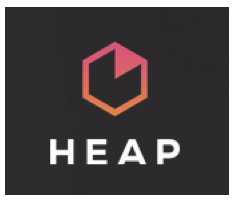 A Q&A with Heap co-founder Ravi Parikh. The Menlo Park-based startup, which offers an analytics tool that captures every user interaction and makes them available instantly as actionable data, completed a $2 million Seed funding round in late August. Investors include Y-Combinator, SV Angel, Redpoint Ventures, Salesforce, William Morris Endeavor, Netprice and RTA Capital. Heap was founded early this year by Parikh and Matin Movassate, and was part of Y-Combinator’s Winter 2013 class.
A Q&A with Heap co-founder Ravi Parikh. The Menlo Park-based startup, which offers an analytics tool that captures every user interaction and makes them available instantly as actionable data, completed a $2 million Seed funding round in late August. Investors include Y-Combinator, SV Angel, Redpoint Ventures, Salesforce, William Morris Endeavor, Netprice and RTA Capital. Heap was founded early this year by Parikh and Matin Movassate, and was part of Y-Combinator’s Winter 2013 class.
SUB: Please describe Heap and your primary innovation.
Parikh: Heap is a user analytics tool that automatically captures every user interaction and lets you analyze it all instantly. You can generate powerful event-based analytics without having to push any tracking code, and without having to wait days or weeks for data to trickle in.
Integration couldn’t be easier. After adding Heap to a website or mobile iOS app, Heap starts capturing every click, form submission, page view, tap, and swipe. You can then organize these events after-the-fact to create funnels, segment users, flexibly slice and dice data, or even view the paths individual users take within your product.
All analysis is completely retroactive. Since Heap captures everything from day one, any relevant business data is already waiting for you, without requiring extra work. You can then ask questions and receive answers immediately. If you had to manually instrument events of interest, the process would require an engineer’s time and take days or weeks to complete.
No other analytics tools can make these claims, and for good reason. Handling such a large volume of data, while introducing virtually zero client-side performance overhead, is a serious technical undertaking.
SUB: Who are your target markets and users?
Parikh: Anyone with a website or mobile app. Marketers and other non-technical people are particularly big fans of Heap, because they no longer need to bug an engineer to write analytics code on their behalf.
Analytics is upstream of many important decisions at businesses, whether it be in marketing, product development, design, or sales. Universally, when people ship a version one of their product, the very first external tool they install is analytics. We strive to be that first-stop tool.
We have a very diverse set of customers, each with unique use cases for Heap:
One of our larger customers—a home appliance company—sells a product on their website, which a user can later activate on their iPhone. This company uses Heap’s web and iOS integrations to tie together a user’s actions across both platforms, allowing them to calculate accurate, cross-device conversion funnels.
Another large customer runs an international ecommerce website selling a wide variety of products. They use Heap’s ad hoc user tagging abilities to answer questions like “Show me this purchasing conversion funnel grouped by the number of times the user visited a product page.” They can generate these events and cohorts on-the-fly effortlessly.
Another large customer was initially attracted to Heap’s retroactive data analysis capabilities, using it in circumstances when they made a mistake instrumenting code with KISSMetrics, or they forgot to track a particular event. Initially, Heap was just a complementary tool. But over time, they’ve begun to move all of their events onto Heap and now use it as their primary analytics tool, since integration was so effortless.
One of our customers sells medical imaging software. While they don’t have a large user base, each one of their customers has an extremely high lifetime value. They use Heap’s User List view to visualize the full clickstream and path of their visitors, allowing them to better tailor one-on-one sales pitches with potential leads.
SUB: Who do you consider to be your competition, and what differentiates Heap from the competition?
Parikh: Heap is the first tool to automatically track everything, and to let you quantify it all flexibly and instantly. No one has built what we’ve built.
Many analytics companies today have maddeningly identical products: you write code to track events of interest, you ship that code, you wait for data to accumulate, and you use standard visualization tools to make sense of it all. When you have new analytics questions, or when your website or app changes, you rinse and repeat. This is a poor feedback loop and a hassle to maintain. As a result, we’ve found that many of our customers are switching from these tools over to us completely.
SUB: What was the inspiration behind the idea for Heap? Was there an ‘aha’ moment, or was the idea more gradual in developing?
Parikh: My co-founder Matin used to work as a product manager at Facebook. A large part of his job was making data-driven product decisions, but he was constantly bogged down by the lengthy analytics cycles. Every time he wanted to answer a simple question, he would need to bug a developer to write tracking code on his behalf. Once the developer found the time to write code, he would need to wait for the next code push. Then, he would need to wait for enough data to accumulate. Finally, he was able to answer his question, days or weeks after the initial question was asked. It was just too difficult for him to make meaningful use of metrics with such a poor feedback loop.
On mobile, the problem is even worse: release cycles on iOS can take months due to Apple’s App Store approval process. Heap reduces this process by several orders of magnitude: just login to Heap, ask your question, and receive an answer seconds later.
SUB: You recently closed a $2 million Seed funding round. How do you plan to use the funds?
Parikh: Most of the funding will go towards hiring talented developers and designers. The potential surface area for Heap is vast, and the engineering challenges are unprecedented. Right now, the highest leveraged way of growing the company is by further iterating on the product and scaling it out to more and more businesses.
SUB: Do you have plans to seek additional outside funding in the near future?
Parikh: Right now, we’re all set with our funding round. We’re profitable and growing quickly, so we have the luxury of being very judicious with raising money.
SUB: What have the most significant challenges been so far to building the company?
Parikh: By virtue of tracking everything, we serve orders of magnitude more data volume than any other analytics provider. Analyzing that swath of data in real-time is particularly challenging, and requires a serious investment in our part on building world-class infrastructure.
Another big challenge is designing an interface that allows people to separate signal from noise. Heap’s UI has to support a fundamentally different analytics flow, while minimizing the amount of technical expertise required to understand the data. It’s an unsolved problem, and we’re constantly iterating on the details.
SUB: How do you generate revenue or plan to generate revenue?
Parikh: Currently, we charge for Heap on a per-user basis. The more traffic a website sees, the more it costs to use Heap. Notably, we don’t charge per data point—we think that misaligns incentives, forcing customers to spend too much time picking and choosing the right metrics, which is never done right on the first try, anyways.
We also started offering a 60-day free trial, which allows people to evaluate Heap with a complete, full-featured version of the product. We wanted to be especially generous with the trial period, because we’ve seen extremely high retention rates for people that install Heap.
SUB: What are your goals for Heap over the next year or so?
Parikh: Right now, analytics tools are the domain of data scientists and engineers. We envision a world in which anyone can make data-driven decisions without the need for specialized knowledge.
In the short term, we’re expanding Heap integration onto other platforms, including Android and server-side frameworks. We also have a number of exciting updates in store that should make post-hoc analysis in Heap both easier and more powerful.
Heap – www.heapanalytics.com












